Suppose the Sample Space for a Continuous Random Variable is 0 to 200
The uniform distribution is a continuous probability distribution and is concerned with events that are equally likely to occur. When working out problems that have a uniform distribution, be careful to note if the data is inclusive or exclusive.
Example 1
The data in the table below are 55 smiling times, in seconds, of an eight-week-old baby.
| 10.4 | 19.6 | 18.8 | 13.9 | 17.8 | 16.8 | 21.6 | 17.9 | 12.5 | 11.1 | 4.9 |
| 12.8 | 14.8 | 22.8 | 20.0 | 15.9 | 16.3 | 13.4 | 17.1 | 14.5 | 19.0 | 22.8 |
| 1.3 | 0.7 | 8.9 | 11.9 | 10.9 | 7.3 | 5.9 | 3.7 | 17.9 | 19.2 | 9.8 |
| 5.8 | 6.9 | 2.6 | 5.8 | 21.7 | 11.8 | 3.4 | 2.1 | 4.5 | 6.3 | 10.7 |
| 8.9 | 9.4 | 9.4 | 7.6 | 10.0 | 3.3 | 6.7 | 7.8 | 11.6 | 13.8 | 18.6 |
The sample mean = 11.49 and the sample standard deviation = 6.23.
We will assume that the smiling times, in seconds, follow a uniform distribution between zero and 23 seconds, inclusive. This means that any smiling time from zero to and including 23 seconds is equally likely. The histogram that could be constructed from the sample is an empirical distribution that closely matches the theoretical uniform distribution.
LetX = length, in seconds, of an eight-week-old baby's smile.
The notation for the uniform distribution isX ~ U(a, b) where a = the lowest value of x and b = the highest value of x.
The probability density function is
for a ≤ x ≤ b.
For this example,X ~ U(0, 23) and
for 0 ≤ X ≤ 23.
Formulas for the theoretical mean and standard deviation are
For this problem, the theoretical mean and standard deviation are
Notice that the theoretical mean and standard deviation are close to the sample mean and standard deviation in this example.
Try It
The data that follow are the number of passengers on 35 different charter fishing boats. The sample mean = 7.9 and the sample standard deviation = 4.33. The data follow a uniform distribution where all values between and including zero and 14 are equally likely. State the values ofa and b. Write the distribution in proper notation, and calculate the theoretical mean and standard deviation.
| 1 | 12 | 4 | 10 | 4 | 14 | 11 |
| 7 | 11 | 4 | 13 | 2 | 4 | 6 |
| 3 | 10 | 0 | 12 | 6 | 9 | 10 |
| 5 | 13 | 4 | 10 | 14 | 12 | 11 |
| 6 | 10 | 11 | 0 | 11 | 13 | 2 |
a is zero; b is 14; X ~ U (0, 14); μ = 7 passengers; σ = 4.04 passengers
Example 2
- Refer to Example 1 What is the probability that a randomly chosen eight-week-old baby smiles between two and 18 seconds?
- Find the 90th percentile for an eight-week-old baby's smiling time.
- Find the probability that a random eight-week-old baby smiles more than 12 seconds knowing that the baby smiles more than eight seconds.
Solution
- Find P(2 < x < 18).
- Ninety percent of the smiling times fall below the 90th percentile, k, so P(x <k) = 0.90
- This probability question is a conditional. You are asked to find the probability that an eight-week-old baby smiles more than 12 seconds when you already know the baby has smiled for more than eight seconds.FindP(x > 12|x > 8) There are two ways to do the problem.
- For the first way, use the fact that this is a conditional and changes the sample space. The graph illustrates the new sample space. You already know the baby smiled more than eight seconds.Write a newf(x):
for 8 < x < 23
- For the second way, use the conditional formula (shown below) with the original distribution X ~ U (0, 23):For this problem,A is (x > 12) and B is (x > 8).
- For the first way, use the fact that this is a conditional and changes the sample space. The graph illustrates the new sample space. You already know the baby smiled more than eight seconds.Write a newf(x):
Try It
A distribution is given asX ~ U (0, 20). What is P(2 < x < 18)? Find the 90th percentile.
P(2 < x < 18) = 0.8; 90th percentile = 18
Example 3
The amount of time, in minutes, that a person must wait for a bus is uniformly distributed between zero and 15 minutes, inclusive.
- What is the probability that a person waits fewer than 12.5 minutes?
- On the average, how long must a person wait? Find the mean, μ, and the standard deviation, σ.
- Ninety percent of the time, the time a person must wait falls below what value? This asks for the 90th percentile.
Solution
- Let X = the number of minutes a person must wait for a bus. a = 0 and b = 15. X~ U(0, 15). Write the probability density function.
for 0 ≤x ≤ 15.FindP (x < 12.5). Draw a graph.
The probability a person waits less than 12.5 minutes is 0.8333. -
. On the average, a person must wait 7.5 minutes.
The standard deviation is 4.3 minutes. - Find the 90th percentile. Draw a graph. Let k = the 90th percentile.
k is sometimes called a critical value.The 90th percentile is 13.5 minutes. Ninety percent of the time, a person must wait at most 13.5 minutes.
Try It
The total duration of baseball games in the major league in the 2011 season is uniformly distributed between 447 hours and 521 hours inclusive.
- Find a and b and describe what they represent.
- Write the distribution.
- Find the mean and the standard deviation.
- What is the probability that the duration of games for a team for the 2011 season is between 480 and 500 hours?
- What is the 65th percentile for the duration of games for a team for the 2011 season?
- a is 447, and b is 521. a is the minimum duration of games for a team for the 2011 season, and b is the maximum duration of games for a team for the 2011 season.
- X ~ U (447, 521).
- μ = 484, and σ = 21.36
- P(480 < x < 500) = 0.2703
- 65th percentile is 495.1 hours.
Example 4
Suppose the time it takes a nine-year old to eat a donut is between 0.5 and 4 minutes, inclusive. LetX = the time, in minutes, it takes a nine-year old child to eat a donut. Then X~ U (0.5, 4).
- The probability that a randomly selected nine-year old child eats a donut in at least two minutes is _______.
- Find the probability that a different nine-year old child eats a donut in more than two minutes given that the child has already been eating the donut for more than 1.5 minutes.
Solution
- 0.5714
- This question has a conditional probability. You are asked to find the probability that a nine-year old child eats a donut in more than two minutes given that the child has already been eating the donut for more than 1.5 minutes. Solve the problem two different ways (see Example 3). You must reduce the sample space.
- First way: Since you know the child has already been eating the donut for more than 1.5 minutes, you are no longer starting at a = 0.5 minutes. Your starting point is 1.5 minutes. Write a newf(x):
FindP(x > 2|x > 1.5). Draw a graph.
The probability that a nine-year old child eats a donut in more than two minutes given that the child has already been eating the donut for more than 1.5 minutes is
. - Second way: Draw the original graph for X ~ U (0.5, 4). Use the conditional formula
- First way: Since you know the child has already been eating the donut for more than 1.5 minutes, you are no longer starting at a = 0.5 minutes. Your starting point is 1.5 minutes. Write a newf(x):
Try It
Suppose the time it takes a student to finish a quiz is uniformly distributed between six and 15 minutes, inclusive. LetX = the time, in minutes, it takes a student to finish a quiz. Then X ~ U (6, 15).
Find the probability that a randomly selected student needs at least eight minutes to complete the quiz. Then find the probability that a different student needs at least eight minutes to finish the quiz given that she has already taken more than seven minutes.
P (x > 8) = 0.7778
P (x > 8 | x > 7) = 0.875
Example 5
Ace Heating and Air Conditioning Service finds that the amount of time a repairman needs to fix a furnace is uniformly distributed between 1.5 and four hours. Letx = the time needed to fix a furnace. Then x ~ U (1.5, 4).
- Find the probability that a randomly selected furnace repair requires more than two hours.
- Find the probability that a randomly selected furnace repair requires less than three hours.
- Find the 30th percentile of furnace repair times.
- The longest 25% of furnace repair times take at least how long? (In other words: find the minimum time for the longest 25% of repair times.) What percentile does this represent?
- Find the mean and standard deviation
Solution
- To findf(x):
P(x > 2) = (base)(height) = (4 – 2)(0.4) = 0.8
Uniform Distribution between 1.5 and four with shaded area between two and four representing the probability that the repair time
x is greater than two
- P(x < 3) = (base)(height) = (3 – 1.5)(0.4) = 0.6The graph of the rectangle showing the entire distribution would remain the same. However the graph should be shaded between
x = 1.5 and x = 3. Note that the shaded area starts at x = 1.5 rather than at x = 0; since X ~ U (1.5, 4), x can not be less than 1.5.
Uniform Distribution between 1.5 and four with shaded area between 1.5 and three representing the probability that the repair timex is less than three
-
Uniform Distribution between 1.5 and 4 with an area of 0.30 shaded to the left, representing the shortest 30% of repair times.
P (x < k) = 0.30
P(x < k) = (base)(height) = (k – 1.5)(0.4)0.3 = (k – 1.5) (0.4); Solve to find k:0.75 =k – 1.5, obtained by dividing both sides by 0.4
k = 2.25 , obtained by adding 1.5 to both sidesThe 30th percentile of repair times is 2.25 hours. 30% of repair times are 2.5 hours or less.
-
Uniform Distribution between 1.5 and 4 with an area of 0.25 shaded to the right representing the longest 25% of repair times.P(x > k) = 0.25
P(x > k) = (base)(height) = (4 – k)(0.4)0.25 = (4 –k)(0.4); Solve for k:0.625 = 4 −k, obtained by dividing both sides by 0.4
−3.375 = −k, obtained by subtracting four from both sides: k = 3.375
The longest 25% of furnace repairs take at least 3.375 hours (3.375 hours or longer).
Note: Since 25% of repair times are 3.375 hours or longer, that means that 75% of repair times are 3.375 hours or less. 3.375 hours is the 75th percentile of furnace repair times.
-
Try It
The amount of time a service technician needs to change the oil in a car is uniformly distributed between 11 and 21 minutes. LetX = the time needed to change the oil on a car.
- Write the random variable X in words. X = __________________.
- Write the distribution.
- Graph the distribution.
- Find P (x > 19).
- Find the 50th percentile.
- Let X = the time needed to change the oil in a car.
- X ~ U (11, 21).
-
- P (x > 19) = 0.2
- the 50th percentile is 16 minutes.
References
McDougall, John A. The McDougall Program for Maximum Weight Loss. Plume, 1995.
Concept Review
IfX has a uniform distribution where a < x < b or a ≤ x ≤ b, then X takes on values between a and b (may include a and b). All values x are equally likely. We write X ∼ U(a, b). The mean of X is
. X is continuous.
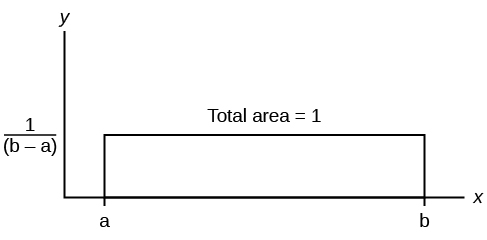
Formula Review
X = a real number between a and b (in some instances, X can take on the values a and b). a = smallest X; b = largest X
X ~ U (a, b)
The mean is
The standard deviation is
Probability density function:
Area to the Left ofx:
Area to the Right ofx:
Area Betweenc and d:
Uniform:X ~ U(a, b) where a < x < b
- pdf:
for a ≤ x ≤ b - cdf: P(X ≤ x) =
- mean:
- standard deviation:
- P(c < X < d) = (d – c)
Licenses and Attributions
Source: https://www.coursehero.com/study-guides/odessa-introstats1-1/the-uniform-distribution/
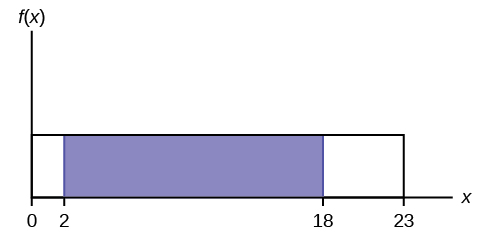

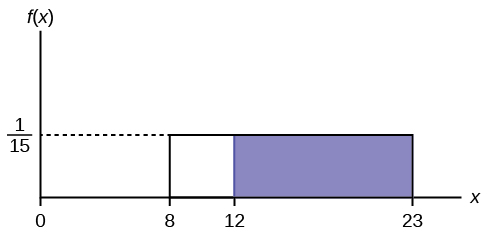
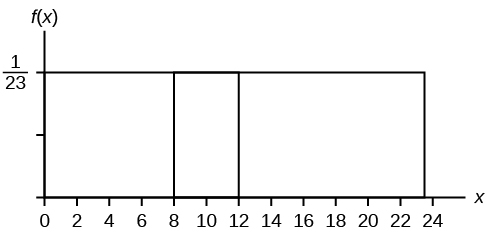

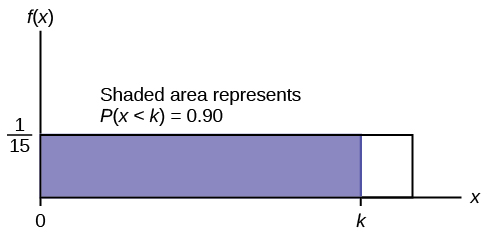
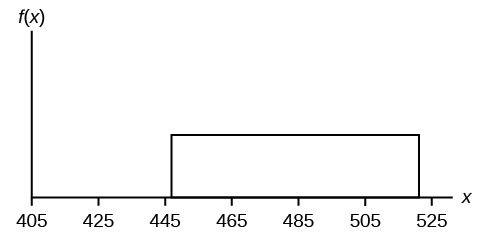


0 Response to "Suppose the Sample Space for a Continuous Random Variable is 0 to 200"
Post a Comment